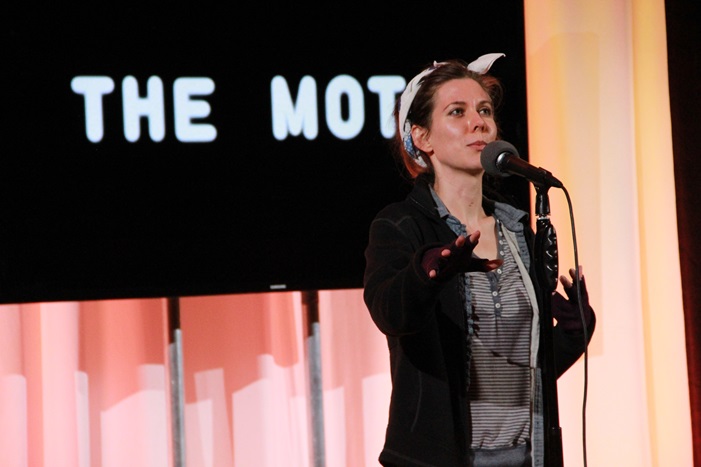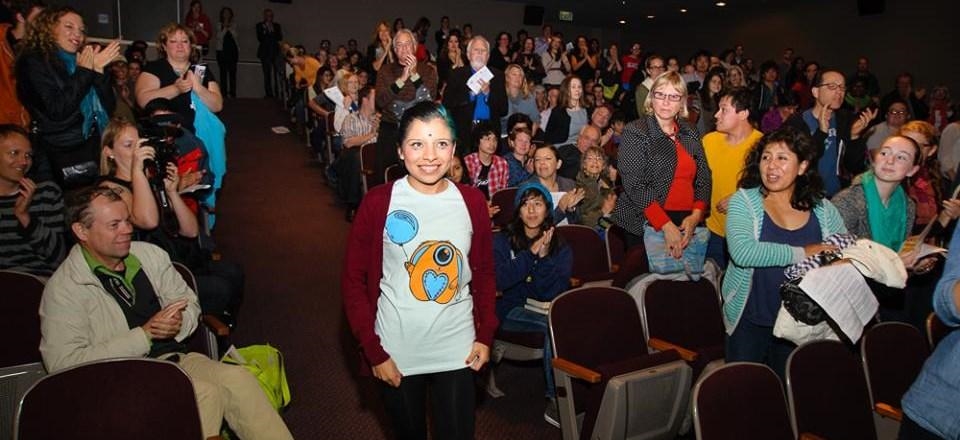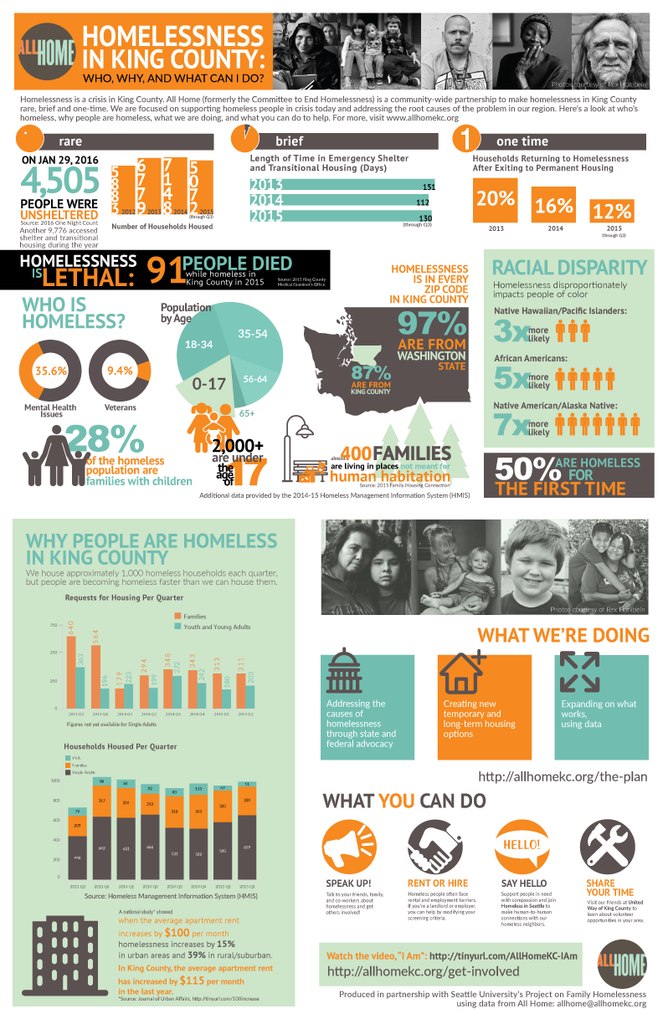One of Firesteel’s favorite guest bloggers, Catherine Hinrichsen, recently shared this great post on the Bill and Melinda Gates Foundation’s Impatient Optimists site. The connection between art and social justice has been on my mind a lot since Path with Art invited me to participate in a June 9 panel discussion, The Role of the Arts in Civic Problem Solving, so this post felt very timely! Thanks to Catherine and the Gates Foundation for permission to repost. –Denise
Written by Catherine Hinrichsen, Project Director, Seattle University Project on Family Homelessness
A young woman of color takes the stage. With a quick prop change and shift of her posture, she becomes several different characters: a young military veteran, a successful business executive, a street paper vendor, all of whom have been hit with homelessness.
We sit forward in our chairs. We are mesmerized. Who will she become next? What will happen to the people whose stories she’s telling? And – most importantly – what can we do to help?
Many years later, though that event was filled with impressive speakers, the only one I really remember was the performance artist Sharon N. Williams of The Mahogany Project. Like the others, Sharon reiterated some central truths: that the paths to homelessness can be different than we think; that homelessness can happen to almost anyone; and that it can be sudden.
What Sharon demonstrated so effectively, though, was the potency of art for advocacy. She showed us that stories and art can:
- Be far more compelling than facts, entertaining and engaging us.
- Help us avoid the “danger of the single story,” a real problem for social-justice issues.
- Enter the part of our brain that creates empathy and holds onto memories long term.
- Evoke a strong desire to do something to help.
And Sharon did this in only a few spell-binding minutes.
In six years of the Seattle University’s Project on Family Homelessness, we’ve used film, photography, public art installations and storytelling to create widespread awareness of and empathy for families experiencing homelessness. Nearly 40 percent of the people who are homeless are families, and the face of homelessness can also be that of a child. We build on that awareness to stimulate emotions, and then present solutions.
In our most successful ventures, we’ve connected art to action and helped change the way our community works to end family homelessness.
We’ve been fortunate to learn from, and collaborate with, many generous and gifted artists and storytellers, including Bryan Ohno of Urban Art Concept; Linda Hartzell (now retired) and her team at Seattle Children’s Theatre; local “Genius” C. Davida Ingram; Troy Carter of Sanctuary Art Center; the five filmmakers who participated in our “American Refugees” Film Fellowship program; our partners at the advocacy network of Washington State YWCAs, Firesteel; the storytelling experts at StoryCorps and The Moth; and many more.
8 THINGS WE’VE LEARNED ABOUT USING ART FOR ADVOCACY
Here’s what we’ve learned about using the power of art and emotion to spark change.
1. Use art to reach people in unexpected ways. Bringing art into public or offbeat spaces, and bringing advocacy into galleries or display spaces, breaks down barriers and allows us to reach new audiences. We may be surprised to see a 22-foot-high spiral sculpture about homelessness gradually rising out of the gravel in our neighborhood park. A fan of cutting-edge animated film might see for the first time a peek into the life of a homeless teenager. A fun field trip to the local children’s theater can mean a class of fourth-graders sees the experiences of an imaginative and resilient homeless boy who could be one of their classmates.

2. Make the art an interactive experience. Find ways to bring together the artist, the subject, and the audience whenever possible so that it’s not just a one-way, passive experience. Ask visitors to react visually or verbally to the art, then incorporate that feedback into a display. When the formerly homeless teen artist Inocente came to Seattle for our screening of the Academy Award-winning documentary about her, she also agreed to be the featured artist at the Gates Foundation Visitor Center’s Family Day. Instead of being behind a podium, she worked side-by-side with children at an art station. This type of interaction also allows the audience to process their feelings and can cement their intent to act.
3. Use art to tell a complex story succinctly and concisely. Art captures humanity, acknowledging that humans are emotional, not rational, decision makers. Infographics can become works of art, drawing us in with vivid visuals to connect us to the people behind the numbers. Here’s one we recently created for our partner organization All Home with data from our recent One Night Count – our county’s annual Point in Time count of homelessness – which is probably our most widely shared graphic ever.
4. Share the stories and art via social media. The internet practically begs for an ongoing stream of shareable images, videos, graphics and art. Social media is also a great entry point for the budding advocate, someone who’s not quite ready to write to Congress but who will eagerly post a video, infographic or photo on Facebook.
5. Keep repurposing the art and use it in different ways. Our Journalism Fellow Dan Lamont, an accomplished photojournalist, created a beautiful photo collection of six homeless families in Washington state and was extremely generous with how they could be used. Those photos have lived a long, robust life and are still in demand all over the region. Don’t have the resources to create art? Ask to borrow some. Remember that especially for social media, the creation of content is only a small part of our task; the stories and art must be promoted and re-shared repeatedly.
6. Empower the people telling the stories. The most compelling stories emerge when people who may have been marginalized have the power to choose how they want their own stories to be told. Through our partnerships with storytelling experts like StoryCorps and The Moth, we’ve been able to put the storytellers front and center with dignity and authenticity.
StoryCorps, best known for its Friday-morning segments on National Public Radio’s Morning Edition, worked with us to record stories from more than 150 local people affected by family homelessness. Three of those stories were chosen to air nationally, and nine aired on one of our local public radio stations, KUOW.

Our partnership with The Moth invited 18 storytellers to learn how to craft a personal five-minute story about homelessness, and showcased nine of those stories at an evening event at Fremont Abbey in Seattle. Much to our surprise and delight, eight of the stories have been slated for airing on The Moth Radio Hour to more than 500 stations nationwide.

Through these partnership with StoryCorps and The Moth, millions of people nationwide have listened to enthralling stories of family homelessness, delivered via two of the world’s most beloved storytelling platforms with built-in, devoted listeners.
7. It’s okay when art makes us uncomfortable. I don’t mean that we should deliberately provoke negative reactions, or use exploitation to be provocative. Quite the opposite; art needs to respect the dignity and privacy of all human beings, especially vulnerable people. But honest, authentic art may present a realistic depiction of poverty that makes us want to turn away. When that happens, we must first acknowledge our own biases and then lead our community into a discussion about it.
Finally, and most importantly for making change:
8. Pair the art with clear calls to action, and repeat the ask. Even the most blatant advocacy art is not enough in itself. Have you ever seen a hard-hitting documentary that opened your eyes and changed your views, but then taken no action afterwards? After you activate an emotional response, always give your audience a few simple action steps. Then keep following up with them. The Facing Homelessness organization, with its photos by Rex Hohlbein, is especially adept at this, pairing striking photos with personal stories and clear, easy ways to help.
CREATING CHANGE: A SUCCESS STORY

One of our most successful experiences with art for advocacy combined clean graphics aimed at policy-makers with supporting stories from our StoryCorps collection as well as the American Refugees films.
For three years, one of our advocacy partners, Columbia Legal Services, has been working to pass innovative legislation to address student homelessness in Washington state. At the start, many legislators didn’t even know there were homeless students at all. We helped set the stage by creating the infographic above, and motivated both advocates and policymakers to act with the emotional pull of the stories of homeless students.
Along with determined direct advocacy and increased media attention, this art for advocacy helped make the case for a new law increasing resources and support for homeless students, recently signed by Gov. Jay Inslee.
WANT TO LEARN MORE?
- Watch our four animated “American Refugees” short films.
- See the video of a longer version of Sharon Williams’ performance-art piece on homelessness.
- Listen to stories from our projects with StoryCorps and The Moth.
Panel Discussion: The Role of the Arts in Civic Problem Solving
June 9, 6:30-8:30 pm at V2 | 1525 11th Ave on Capitol Hill in Seattle
Join Path with Art for a panel discussion and public forum exploring The Role of the Arts in Civic Problem Solving. How are the arts a tool for change? How do the arts broaden our creative thinking abilities as we search for new solutions to existing civic issues? How can the arts bring diverse communities together for productive exchange?
Seattle’s Office of Arts and Culture Director, Randy Engstrom, will moderate the discussion. Panelists include:
- Lisa Herbold, Seattle City Councilmember, District 1, and Chair of the Civil Rights, Utilities, Economic Development and Arts Committee
- Joshua Kohl, co-founder and co-artistic director of the Degenerate Art Ensemble
- Denise Miller, Firesteel Advocacy Manager, YWCA
- Mary Moody, singer and Path with Art student
- Barbara Earl Thomas, artist and former Executive Director of the Northwest African American Museum

